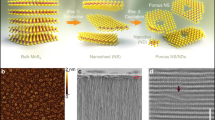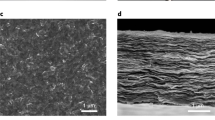Abstract
Stacking two-dimensional nanosheets into laminar membranes to create nanochannels has attracted widespread attention at both fundamental and practical levels in separation technology. Constructing space-tunable and long-term stable sub-nanometre channels provides original systems for nanofluidic investigations and accurate molecular sieving. Here we report a scalable strategy for the preparation of non-swelling, covalently functionalized MoS2 membranes with tunable cohesion energy and interlayer space ranging from 3.5 to 7.7 Å, depending on the nature of the functional groups attached to the MoS2 nanosheets. We evaluated the relationship between the capillary width, surface chemistry, stacking disorder and sieving behaviour of the membranes in forwards osmosis (FO). By combining experimental investigations and numerical simulations, we determined that functionalization with aryl groups induces the formation of a capillary width of 7.1 Å and an interlayer stiffness as low as 5.6 eV Å−2, leading to controlled stacking defects. We also report the fabrication of membranes with an area of up to 45 cm2 that demonstrate a salt rejection as high as 94.2% for a continuous operating time of 7 days. Furthermore, the desalination strategy in FO has a specific energy consumption of 4 × 10−3 kWh m−3, which compares favourably with commercial FO membranes.
This is a preview of subscription content, access via your institution
Access options
Subscribe to this journal
Receive 12 digital issues and online access to articles
$99.00 per year
only $8.25 per issue
Buy this article
- Purchase on Springer Link
- Instant access to full article PDF
Prices may be subject to local taxes which are calculated during checkout






Similar content being viewed by others
Data availability
The data that support the plots within this paper and other findings of this study are available from FigShare (https://doi.org/10.6084/m9.figshare.21901638.v1).
References
Shen, J., Liu, G., Han, Y. & Jin, W. Artificial channels for confined mass transport at the sub-nanometre scale. Nat. Rev. Mater. 6, 294–312 (2021).
Werber, J. R., Osuji, C. O. & Elimelech, M. Materials for next-generation desalination and water purification membranes. Nat. Rev. Mater. 1, 16018 (2016).
Wang, S. et al. Two-dimensional nanochannel membranes for molecular and ionic separations. Chem. Soc. Rev. 49, 1071–1089 (2020).
Kang, Y., Xia, Y., Wang, H. & Zhang, X. 2D laminar membranes for selective water and ion transport. Adv. Funct. Mater. 29, 1902014 (2019).
Cheng, L., Liu, G., Zhao, J. & Jin, W. Two-dimensional-material membranes: manipulating the transport pathway for molecular separation. Acc. Mater. Res. 2, 114–128 (2021).
Safaei, J., Xiong, P. & Wang, G. Progress and prospects of two-dimensional materials for membrane-based water desalination. Mater. Today Adv. 8, 100108 (2020).
Liu, P. et al. Two-dimensional material membranes for critical separations. Inorg. Chem. Front. 7, 2560–2581 (2020).
Cheng, Y., Pu, Y. & Zhao, D. Two‐dimensional membranes: new paradigms for high‐performance separation membranes. Chem. Asian J. 15, 2241–2270 (2020).
Joshi, R. et al. Precise and ultrafast molecular sieving through graphene oxide membranes. Science 343, 752–754 (2014).
Abraham, J. et al. Tunable sieving of ions using graphene oxide membranes. Nat. Nanotechnol. 12, 546–550 (2017).
Chen, L. et al. Ion sieving in graphene oxide membranes via cationic control of interlayer spacing. Nature 550, 380–383 (2017).
Shen, J. et al. Subnanometer two-dimensional graphene oxide channels for ultrafast gas sieving. ACS Nano 10, 3398–3409 (2016).
Hung, W.-S. et al. Cross-linking with diamine monomers to prepare composite graphene oxide-framework membranes with varying d-spacing. Chem. Mater. 26, 2983–2990 (2014).
Zheng, S., Tu, Q., Urban, J. J., Li, S. & Mi, B. Swelling of graphene oxide membranes in aqueous solution: characterization of interlayer spacing and insight into water transport mechanisms. ACS Nano 11, 6440–6450 (2017).
Su, P., Wang, F., Li, Z., Tang, C. Y. & Li, W. Graphene oxide membranes: controlling their transport pathways. J. Mater. Chem. A 8, 15319–15340 (2020).
Han, Z.-y. et al. A review of performance improvement strategies for graphene oxide-based and graphene-based membranes in water treatment. J. Mater. Sci. 56, 9545–9574 (2021).
Sun, L., Huang, H. & Peng, X. Laminar MoS2 membranes for molecule separation. Chem. Commun. 49, 10718–10720 (2013).
Guo, B.-Y. et al. MoS2 membranes for organic solvent nanofiltration: stability and structural control. J. Phys. Chem. Lett. 10, 4609–4617 (2019).
Ren, C. E. et al. Charge- and size-selective ion sieving through Ti3C2Tx MXene membranes. J. Phys. Chem. Lett. 6, 4026–4031 (2015).
Ding, L. et al. A two‐dimensional lamellar membrane: MXene nanosheet stacks. Angew. Chem. Int. Ed. 56, 1825–1829 (2017).
Wang, J. et al. Ion sieving by a two-dimensional Ti3C2Tx alginate lamellar membrane with stable interlayer spacing. Nat. Commun. 11, 3540 (2020).
Kim, S., Wang, H. & Lee, Y. M. 2D nanosheets and their composite membranes for water, gas, and ion separation. Angew. Chem. Int. Ed. 131, 17674–17689 (2019).
Wang, Z. et al. Understanding the aqueous stability and filtration capability of MoS2 membranes. Nano Lett. 17, 7289–7298 (2017).
Ries, L. et al. Enhanced sieving from exfoliated MoS2 membranes via covalent functionalization. Nat. Mater. 18, 1112–1117 (2019).
Mei, L. et al. Simultaneous electrochemical exfoliation and covalent functionalization of MoS2 membrane for ion sieving. Adv. Mater. 34, 2201416 (2022).
Chu, C. et al. Precise ångström controlling the interlayer channel of MoS2 membranes by cation intercalation. J. Memb. Sci. 615, 118520 (2020).
Eda, G. et al. Photoluminescence from chemically exfoliated MoS2. Nano Lett. 11, 5111–5116 (2011).
Creemers, A. F. & Lugtenburg, J. The preparation of all-trans uniformly 13C-labeled retinal via a modular total organic synthetic strategy. Emerging central contribution of organic synthesis toward the structure and function study with atomic resolution in protein research. J. Am. Chem. Soc. 124, 6324–6334 (2002).
Duthaler, R. O., Förster, H. & Roberts, J. D. Nitrogen-15 and carbon-13 nuclear magnetic resonance spectra of diazo and diazonium compounds. J. Am. Chem. Soc. 100, 4974–4979 (1978).
Nightingale, E.Jr. Phenomenological theory of ion solvation. Effective radii of hydrated ions. J. Phys. Chem. 63, 1381–1387 (1959).
Teychené, J., Roux-de Balmann, H., Maron, L. & Galier, S. Investigation of ions hydration using molecular modeling. J. Mol. Liq. 294, 111394 (2019).
Wei, Y. et al. Declining flux and narrowing nanochannels under wrinkles of compacted graphene oxide nanofiltration membranes. Carbon 108, 568–575 (2016).
Morelos-Gomez, A. et al. Effective NaCl and dye rejection of hybrid graphene oxide/graphene layered membranes. Nat. Nanotechnol. 12, 1083–1088 (2017).
Hoenig, E. et al. Controlling the structure of MoS2 membranes via covalent functionalization with molecular spacers. Nano Lett. 20, 7844–7851 (2020).
Chekli, L. et al. A comprehensive review of hybrid forward osmosis systems: performance, applications and future prospects. J. Memb. Sci. 497, 430–449 (2016).
Wang, K. Y., Chung, T.-S. & Qin, J.-J. Polybenzimidazole (PBI) nanofiltration hollow fiber membranes applied in forward osmosis process. J. Memb. Sci. 300, 6–12 (2007).
Lu, X. et al. Relating selectivity and separation performance of lamellar two-dimensional molybdenum disulfide (MoS2) membranes to nanosheet stacking behavior. Environ. Sci. Technol. 54, 9640–9651 (2020).
Alturki, A. et al. Performance of a novel osmotic membrane bioreactor (OMBR) system: flux stability and removal of trace organics. Bioresour. Technol. 113, 201–206 (2012).
Andreeva, D. V. et al. Two-dimensional adaptive membranes with programmable water and ionic channels. Nat. Nanotechnol. 16, 174–180 (2021).
Al-aibi, S., Mahood, H. B., Sharif, A. O., Alpay, E. & Simcoe-Read, H. Evaluation of draw solution effectiveness in a forward osmosis process. Desalination Water Treat. 57, 13425–13432 (2016).
Li, G., Li, X.-M., He, T., Jiang, B. & Gao, C. Cellulose triacetate forward osmosis membranes: preparation and characterization. Desalination Water Treat. 51, 2656–2665 (2013).
Zou, S. & He, Z. Enhancing wastewater reuse by forward osmosis with self-diluted commercial fertilizers as draw solutes. Water Res. 99, 235–243 (2016).
Lambrechts, R. & Sheldon, M. Performance and energy consumption evaluation of a fertiliser drawn forward osmosis (FDFO) system for water recovery from brackish water. Desalination 456, 64–73 (2019).
Al-Karaghouli, A. & Kazmerski, L. L. Energy consumption and water production cost of conventional and renewable-energy-powered desalination processes. Renew. Sustain. Energy Rev. 24, 343–356 (2013).
Shannon, M. A. et al. Science and technology for water purification in the coming decades. Nature 452, 301–310 (2008).
Qin, M. & He, Z. Self-supplied ammonium bicarbonate draw solute for achieving wastewater treatment and recovery in a microbial electrolysis cell-forward osmosis-coupled system. Environ. Sci. Technol. Lett. 1, 437–441 (2014).
Horvath A. L. Handbook of Aqueous Electrolyte Solutions (Halsted Press, 1985).
Plimpton, S. Fast parallel algorithms for short-range molecular dynamics. J. Comput. Phys. 117, 1–19 (1995).
Jorgensen, W. L., Maxwell, D. S. & Tirado-Rives, J. Development and testing of the OPLS all-atom force field on conformational energetics and properties of organic liquids. J. Am. Chem. Soc. 118, 11225–11236 (1996).
Sresht, V. et al. Quantitative modeling of MoS2–solvent interfaces: predicting contact angles and exfoliation performance using molecular dynamics. J. Phys. Chem. C 121, 9022–9031 (2017).
Onofrio, N. & Ko, T. W. Exploring the compositional ternary diagram of Ge/S/Cu glasses for resistance switching memories. J. Phys. Chem. C 123, 9486–9495 (2019).
Acknowledgements
This study was supported by the French National Agency (ANR, programme 2D-MEMBA, ANR-21-CE09-0034-01). D.V., K.Q. and H.W. acknowledge funding from the European Research Council (ERC) under the European Union’s Horizon 2020 research and innovation programme (grant agreement no. 804320). W.W., J. Liu and J. Li acknowledge Ph.D. scholarships from the China Scholarship Council (CSC). C.S. acknowledges funding from the French National Agency (ANR, JCJC programme, MONOMEANR-20-CE08-0009). K.Q. and Y.Z. acknowledge financial support from the China Postdoctoral Science Foundation (2018M633127) and the Natural Science Foundation of Guangdong Province (2018A030310602). J. Li acknowledges financial support from the National Natural Science Foundation of China (21808134). The French Région Ile-de-France – SESAME programme is acknowledged for financial support (700 MHz NMR spectrometer). GENCI granted access to the HPC resources of IDRIS under allocation 2021-2022-A0110913046 and 097535. L.L. acknowledges funding from the Andalusian regional government (FEDER-UCA-18-107490), the European Union’s Horizon 2020 research and innovation programme (grant agreement no. 823717 – ESTEEM3), the Spanish Ministerio de Economía y Competitividad (PID2019-107578GA-I00), the Ministerio de Ciencia e Innovación MCIN/AEI/10.13039/501100011033 and the European Union ‘NextGenerationEU’/PRTR (RYC2021-033764-I, CPP2021-008986). The (S)TEM measurements were performed at the National Facility ELECMI ICTS (Division de Microscopía Electrónica, Universidad de Cádiz, DME-UCA).
Author information
Authors and Affiliations
Contributions
D.V. conceived the idea, designed the experiments and wrote the manuscript. W.W. designed the experiments with D.V., synthesized the functionalized nanosheets, fabricated the membranes and performed the experiments. D.V. and W.W. analysed the data and wrote the manuscript. N.O. performed the atomistic calculations and discussed the results with D.V. and W.W. B.A.K. assisted W.S. with the measurements and synthesized MXene. E.P. performed the liquid NMR and HPLC-UV analyses to quantify the membrane rejection, while H.W., J. Liu, J. Li, K.Q. and Y.Z. assisted W.W with the WCA, Raman and Fourier transform infrared measurements. L.L. performed the (S)TEM measurements and analysed the data. C.G. performed the solid-state 13C NMR spectroscopy measurements and discussed the results with C.S. P.M. and Z.Z. discussed the results with W.W. and D.V. All of the authors edited the manuscript before submission.
Corresponding author
Ethics declarations
Competing interests
The authors declare no competing interests.
Peer review
Peer review information
Nature Water thanks Haiping Fang and the other, anonymous, reviewer(s) for their contribution to the peer review of this work.
Additional information
Publisher’s note Springer Nature remains neutral with regard to jurisdictional claims in published maps and institutional affiliations.
Supplementary information
Supplementary Information
Supplementary Figs. 1–21, Notes 1–8 and Tables 1–7.
Rights and permissions
Springer Nature or its licensor (e.g. a society or other partner) holds exclusive rights to this article under a publishing agreement with the author(s) or other rightsholder(s); author self-archiving of the accepted manuscript version of this article is solely governed by the terms of such publishing agreement and applicable law.
About this article
Cite this article
Wang, W., Onofrio, N., Petit, E. et al. High-surface-area functionalized nanolaminated membranes for energy-efficient nanofiltration and desalination in forward osmosis. Nat Water 1, 187–197 (2023). https://doi.org/10.1038/s44221-023-00036-1
Received:
Accepted:
Published:
Issue Date:
DOI: https://doi.org/10.1038/s44221-023-00036-1



